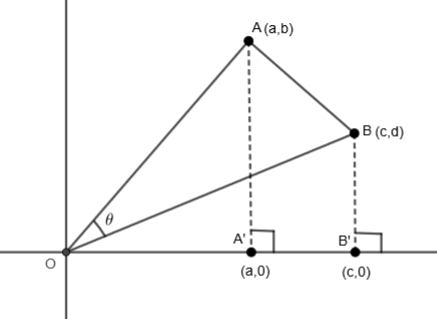
If the line segment joining the points A (a, b) and B (c, d) subtends an angle \[\theta \] at the origin, then \[\cos \theta \] is equal to:
(a) \[\dfrac{ac-bc}{\sqrt{\left( {{a}^{2}}+{{b}^{2}} \right)\left( {{c}^{2}}+{{d}^{2}} \right)}}\]
(b) \[\dfrac{ac+bd}{\sqrt{\left( {{a}^{2}}+{{b}^{2}} \right)\left( {{c}^{2}}+{{d}^{2}} \right)}}\]
(c) \[\dfrac{ac+cd}{\sqrt{\left( {{a}^{2}}+{{b}^{2}} \right)\left( {{c}^{2}}+{{d}^{2}} \right)}}\]
(d) None of these
Answer
594k+ views
Hint: In this question, we will first visualize the given situation and then we will try to apply the trigonometric formula, that is \[\cos \left( \alpha -\beta \right)=\cos \alpha \cos \beta +\sin \alpha \sin \beta \]. Also, we should know that \[\cos \alpha =\dfrac{\text{base}}{\text{hypotenuse}}\] and \[\sin \alpha =\dfrac{\text{perpendicular}}{\text{hypotenuse}}\].
Complete step-by-step answer:
In this question, we have to find the value of \[\cos \theta \] where \[\theta \] is the angle subtended by the line joining A (a, b) and B (c, d) at the origin. Here, we can represent the given situation as,

We have been given that the coordinates of A and B are (a, b) and (c, d) respectively. So, we can write the coordinates of A’ and B’ as (a, 0) and (c, 0) on the x and y axis. Let us consider \[\angle AOA'\] as \[\alpha \] and \[\angle BOB'\] as \[\beta \]. So, we can write,
\[\theta =\alpha -\beta ....\left( i \right)\]
So, from the figure, we can say that
\[\cos \alpha =\dfrac{OA'}{OA}\]
\[\cos \beta =\dfrac{OB'}{OB}\]
By using the distance formula, that is \[\sqrt{{{\left( {{x}_{2}}-{{x}_{1}} \right)}^{2}}+{{\left( {{y}_{2}}-{{y}_{1}} \right)}^{2}}}\], we will find the value of OA’, OA, OB’ and OB. So, we get,
\[OA'=\sqrt{{{\left( a-0 \right)}^{2}}+{{\left( 0-0 \right)}^{2}}}=a\]
\[OB'=\sqrt{{{\left( c-0 \right)}^{2}}+{{\left( 0-0 \right)}^{2}}}=c\]
\[OA=\sqrt{{{\left( a-0 \right)}^{2}}+{{\left( b-0 \right)}^{2}}}=\sqrt{{{a}^{2}}+{{b}^{2}}}\]
\[OB=\sqrt{{{\left( c-0 \right)}^{2}}+{{\left( d-0 \right)}^{2}}}=\sqrt{{{c}^{2}}+{{d}^{2}}}\]
\[AA'=\sqrt{{{\left( a-a \right)}^{2}}+{{\left( b-0 \right)}^{2}}}=b\]
\[BB'=\sqrt{{{\left( c-c \right)}^{2}}+{{\left( d-0 \right)}^{2}}}=d\]
So, we get,
\[\cos \alpha =\dfrac{a}{\sqrt{{{a}^{2}}+{{b}^{2}}}}\]
\[\cos \beta =\dfrac{c}{\sqrt{{{c}^{2}}+{{d}^{2}}}}\]
And, we know that
\[\sin \alpha =\dfrac{AA'}{OA}\] and \[\sin \beta =\dfrac{BB'}{OB}\]
\[\sin \alpha =\dfrac{b}{\sqrt{{{a}^{2}}+{{b}^{2}}}}\] and \[\sin \beta =\dfrac{d}{\sqrt{{{a}^{2}}+{{b}^{2}}}}\]
And we know that \[\theta =\alpha -\beta \]. So, we will take cosine ratios to both sides.
\[\cos \theta =\cos \left( \alpha -\beta \right)\]
Now, we know that,
\[\cos \left( \alpha -\beta \right)=\cos \alpha \cos \beta +\sin \alpha \sin \beta \]
So, we get,
\[\cos \theta =\cos \alpha \cos \beta +\sin \alpha \sin \beta \]
Now, we will put the values of \[\cos \alpha \], \[\cos \beta \], \[\sin \alpha \] and \[\sin \beta \] in the above equation. So, we will get,
\[\cos \theta =\dfrac{a}{\sqrt{{{a}^{2}}+{{b}^{2}}}}\times \dfrac{c}{\sqrt{{{c}^{2}}+{{d}^{2}}}}+\dfrac{b}{\sqrt{{{a}^{2}}+{{b}^{2}}}}\times \dfrac{d}{\sqrt{{{c}^{2}}+{{d}^{2}}}}\]
\[\cos \theta =\dfrac{ac+bd}{\sqrt{{{a}^{2}}+{{b}^{2}}}\sqrt{{{c}^{2}}+{{d}^{2}}}}\]
Hence, option (b) is the right answer.
Note: In this question, it is necessary to visualize the condition by drawing the figure because visualization from the virtual figure won’t help. Also, we may make a mistake at the point where we found that \[\theta =\alpha -\beta \]. Also, considering the correct angles will only give the correct answer.
Complete step-by-step answer:
In this question, we have to find the value of \[\cos \theta \] where \[\theta \] is the angle subtended by the line joining A (a, b) and B (c, d) at the origin. Here, we can represent the given situation as,

We have been given that the coordinates of A and B are (a, b) and (c, d) respectively. So, we can write the coordinates of A’ and B’ as (a, 0) and (c, 0) on the x and y axis. Let us consider \[\angle AOA'\] as \[\alpha \] and \[\angle BOB'\] as \[\beta \]. So, we can write,
\[\theta =\alpha -\beta ....\left( i \right)\]
So, from the figure, we can say that
\[\cos \alpha =\dfrac{OA'}{OA}\]
\[\cos \beta =\dfrac{OB'}{OB}\]
By using the distance formula, that is \[\sqrt{{{\left( {{x}_{2}}-{{x}_{1}} \right)}^{2}}+{{\left( {{y}_{2}}-{{y}_{1}} \right)}^{2}}}\], we will find the value of OA’, OA, OB’ and OB. So, we get,
\[OA'=\sqrt{{{\left( a-0 \right)}^{2}}+{{\left( 0-0 \right)}^{2}}}=a\]
\[OB'=\sqrt{{{\left( c-0 \right)}^{2}}+{{\left( 0-0 \right)}^{2}}}=c\]
\[OA=\sqrt{{{\left( a-0 \right)}^{2}}+{{\left( b-0 \right)}^{2}}}=\sqrt{{{a}^{2}}+{{b}^{2}}}\]
\[OB=\sqrt{{{\left( c-0 \right)}^{2}}+{{\left( d-0 \right)}^{2}}}=\sqrt{{{c}^{2}}+{{d}^{2}}}\]
\[AA'=\sqrt{{{\left( a-a \right)}^{2}}+{{\left( b-0 \right)}^{2}}}=b\]
\[BB'=\sqrt{{{\left( c-c \right)}^{2}}+{{\left( d-0 \right)}^{2}}}=d\]
So, we get,
\[\cos \alpha =\dfrac{a}{\sqrt{{{a}^{2}}+{{b}^{2}}}}\]
\[\cos \beta =\dfrac{c}{\sqrt{{{c}^{2}}+{{d}^{2}}}}\]
And, we know that
\[\sin \alpha =\dfrac{AA'}{OA}\] and \[\sin \beta =\dfrac{BB'}{OB}\]
\[\sin \alpha =\dfrac{b}{\sqrt{{{a}^{2}}+{{b}^{2}}}}\] and \[\sin \beta =\dfrac{d}{\sqrt{{{a}^{2}}+{{b}^{2}}}}\]
And we know that \[\theta =\alpha -\beta \]. So, we will take cosine ratios to both sides.
\[\cos \theta =\cos \left( \alpha -\beta \right)\]
Now, we know that,
\[\cos \left( \alpha -\beta \right)=\cos \alpha \cos \beta +\sin \alpha \sin \beta \]
So, we get,
\[\cos \theta =\cos \alpha \cos \beta +\sin \alpha \sin \beta \]
Now, we will put the values of \[\cos \alpha \], \[\cos \beta \], \[\sin \alpha \] and \[\sin \beta \] in the above equation. So, we will get,
\[\cos \theta =\dfrac{a}{\sqrt{{{a}^{2}}+{{b}^{2}}}}\times \dfrac{c}{\sqrt{{{c}^{2}}+{{d}^{2}}}}+\dfrac{b}{\sqrt{{{a}^{2}}+{{b}^{2}}}}\times \dfrac{d}{\sqrt{{{c}^{2}}+{{d}^{2}}}}\]
\[\cos \theta =\dfrac{ac+bd}{\sqrt{{{a}^{2}}+{{b}^{2}}}\sqrt{{{c}^{2}}+{{d}^{2}}}}\]
Hence, option (b) is the right answer.
Note: In this question, it is necessary to visualize the condition by drawing the figure because visualization from the virtual figure won’t help. Also, we may make a mistake at the point where we found that \[\theta =\alpha -\beta \]. Also, considering the correct angles will only give the correct answer.
Recently Updated Pages
Master Class 12 Business Studies: Engaging Questions & Answers for Success

Master Class 12 Economics: Engaging Questions & Answers for Success

Master Class 12 English: Engaging Questions & Answers for Success

Master Class 12 Maths: Engaging Questions & Answers for Success

Master Class 12 Social Science: Engaging Questions & Answers for Success

Master Class 12 Chemistry: Engaging Questions & Answers for Success

Trending doubts
What are the major means of transport Explain each class 12 social science CBSE

Which are the Top 10 Largest Countries of the World?

Draw a labelled sketch of the human eye class 12 physics CBSE

How much time does it take to bleed after eating p class 12 biology CBSE

Explain sex determination in humans with line diag class 12 biology CBSE

Differentiate between homogeneous and heterogeneous class 12 chemistry CBSE




